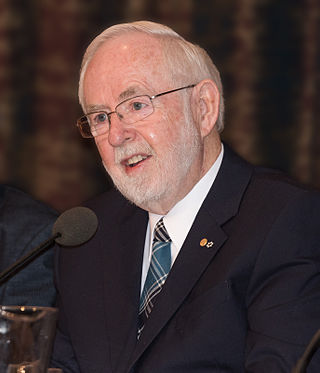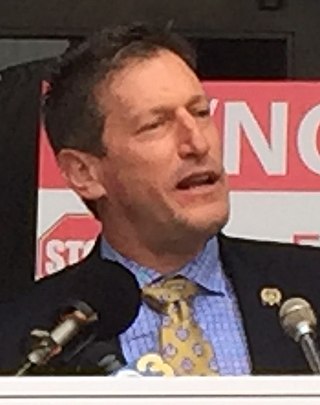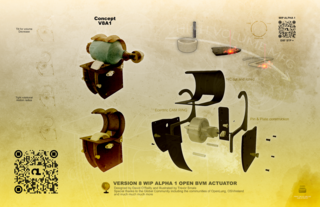Daniel Robert Marlow [1] (born 1954) is a Canadian physicist and fellow of the American Physical Society. A member of the Princeton University faculty since 1984, Marlow is now an emeritus professor of physics.
Daniel Robert Marlow [1] (born 1954) is a Canadian physicist and fellow of the American Physical Society. A member of the Princeton University faculty since 1984, Marlow is now an emeritus professor of physics.
Daniel Marlow was born in Ottawa, Canada, in 1954; his father in the Royal Canadian Navy, so their family moved multiple times while he was growing up. They finally moved to Doylestown, Pennsylvania, where he attended junior high and high school. Marlow attended Carnegie Mellon University in Pittsburgh, eventually graduating with a B.S. and a Ph.D. in physics. From 1980 to 1983, he was a research staffer at Carnegie Mellon, and from 1983 to 1984 he served as an assistant professor. [2]
In 1984, Marlow joined Princeton University as an assistant professor, receiving successive promotions and becoming Professor of Physics in 1995. From 2001 to 2008, Marlow served as the department chair for physics. In 2011, he became Evans Crawford 1911 Professor of Physics. [2] In 2024, Princeton announced Marlow's transition to emeritus status, effective September 1. [3]
Marlow's work includes research on high energy physics; in 2018, Marlow was one of 77 researchers to win research funding towards high energy physics from the U.S. Department of Energy. [4] In 2019, Marlow was the faculty advisor to a project that created a satellite powered by plasma. [5]
Marlow also contributed to technology aimed at managing COVID-19. In 2020, a group of researchers designed a ventilator for use on COVID patients that can be readily produced to alleviate the stress on ventilator production and distribution. [6] Their design became FDA approved. [7] Their device was successfully implemented at Penn Medicine hospitals. [8]

Princeton Plasma Physics Laboratory (PPPL) is a United States Department of Energy national laboratory for plasma physics and nuclear fusion science. Its primary mission is research into and development of fusion as an energy source. It is known for the development of the stellarator and tokamak designs, along with numerous fundamental advances in plasma physics and the exploration of many other plasma confinement concepts.
Engineering physics, or engineering science, refers to the study of the combined disciplines of physics, mathematics, chemistry, biology, and engineering, particularly computer, nuclear, electrical, electronic, aerospace, materials or mechanical engineering. By focusing on the scientific method as a rigorous basis, it seeks ways to apply, design, and develop new solutions in engineering.

Daniel Chee Tsui is an American physicist. He is currently serving as the Professor of Electrical Engineering, emeritus, at Princeton University. Tsui's areas of research include electrical properties of thin films and microstructures of semiconductors and solid-state physics.
The MIT Center for Theoretical Physics (CTP) is the hub of theoretical nuclear physics, particle physics, and quantum information research at MIT. It is a subdivision of MIT Laboratory for Nuclear Science and Department of Physics.

Arthur Bruce McDonald, P.Eng is a Canadian astrophysicist. McDonald is the director of the Sudbury Neutrino Observatory Collaboration and held the Gordon and Patricia Gray Chair in Particle Astrophysics at Queen's University in Kingston, Ontario from 2006 to 2013. He was awarded the 2015 Nobel Prize in Physics jointly with Japanese physicist Takaaki Kajita.
The IEEE Marie Sklodowska-Curie Award is a Technical Field Award that was established by the IEEE Board of Directors in 2008. This award may be presented for outstanding contributions to the field of nuclear and plasma sciences and engineering. This award may be presented to an individual, individuals on a team, or up to three multiple recipients. Recipients of this award receive a bronze medal, certificate, and honorarium. This award was presented for the first time in 2011.
Steven Mark Girvin is an American physicist who is Sterling Professor and former Eugene Higgins Professor of Physics at Yale University. He is noted for his theoretical work on quantum many body systems such as the fractional quantum Hall effect, and as co-developer of circuit quantum electrodynamics, the application of the ideas of quantum optics to superconducting microwave circuits. Circuit QED is now the leading architecture for construction of quantum computers based on superconducting qubits.
Ronald Crosby Davidson was a Canadian physicist, professor, and scientific administrator who worked in the United States. He served as the first director of the MIT Plasma Science and Fusion Center from 1978 to 1988, and as director of the Princeton Plasma Physics Laboratory from 1991 to 1996. He had been Professor of Astrophysical Sciences at Princeton University since 1991.
Ira Borah Bernstein is an American theoretical physicist specializing in plasma physics. He was the first person to formulate the theory of electrostatic waves propagating in a magnetized plasma in 1958, which are now commonly known as Bernstein waves in plasma physics.

Robert Harry Socolow is an American environmental scientist, theoretical physicist and professor emeritus of Mechanical and Aerospace Engineering at Princeton University. He was a founder of the Carbon Mitigation Initiative of Princeton University. He has articulated pathways to reduction of carbon dioxide emissions for minimizing climate change, especially the concept of climate stabilization wedge. Socolow has developed equitable approaches to climate change mitigation that balance reductions in greenhouse gas emissions with economic development.

Andrew P. Zwicker is an American physicist and politician who has served in the New Jersey Senate from the 16th Legislative District since 2022. He previously served in the New Jersey General Assembly representing the 16th District from 2016 to 2022. Zwicker was a candidate for the United States House of Representatives in New Jersey's 12th congressional district in 2014.

Sir Steven Charles Cowley is a British theoretical physicist and international authority on nuclear fusion and astrophysical plasmas. He has served as director of the United States Department of Energy (DOE) Princeton Plasma Physics Laboratory (PPPL) since 1 July 2018. Previously he served as president of Corpus Christi College, Oxford, since October 2016. and head of the EURATOM / CCFE Fusion Association and chief executive officer of the United Kingdom Atomic Energy Authority (UKAEA).
Robert James Goldston is a professor of astrophysics at Princeton University and a former director of the Princeton Plasma Physics Laboratory.
Norman Rostoker was a Canadian plasma physicist known for being a pioneer in developing clean plasma-based fusion energy. He co-founded TAE Technologies in 1998 and held 27 U.S. Patents on plasma-based fusion accelerators.

Emily A. Carter is the Gerhard R. Andlinger Professor in Energy and the Environment and a professor of Mechanical and Aerospace Engineering (MAE), the Andlinger Center for Energy and the Environment (ACEE), and Applied and Computational Mathematics at Princeton University. She is also a member of the executive management team at the Princeton Plasma Physics Laboratory (PPPL), serving as Senior Strategic Advisor and Associate Laboratory Director for Applied Materials and Sustainability Sciences.
Ady Hershcovitch is a plasma physicist best known for his 1995 invention, the plasma window, which was later patented.. In the plasma window, a plasma separates air from a vacuum by preventing the air from rushing into the vacuum. This scientific development can facilitate non-vacuum ion material modification, manufacturing of superalloys, and high-quality non-vacuum electron-beam welding. The device has been compared to the force field in the Star Trek TV series. He is well known for his work in plasma physics at Brookhaven National Laboratory. He has over 80 publications and 15 patents.
Norman C. Jarosik is a US astrophysicist. He has worked on the Wilkinson Microwave Anisotropy Probe (WMAP) whose observations of Cosmic Microwave Background Radiation (CMBR) have provided significant insights into cosmology.

An open-source ventilator is a disaster-situation ventilator made using a freely licensed (open-source) design, and ideally, freely available components and parts. Designs, components, and parts may be anywhere from completely reverse-engineered or completely new creations, components may be adaptations of various inexpensive existing products, and special hard-to-find and/or expensive parts may be 3D-printed instead of purchased. As of early 2020, the levels of documentation and testing of open-source ventilators was well below scientific and medical-grade standards.
Edward E. Thomas Jr. is an American plasma physicist and a Professor of Physics at Auburn University. He currently serves as the university's associate dean for research and graduate studies and is also the university's Charles W. Barkley Endowed Professor for diversity and inclusion. He is a fellow of the National Society of Black Physicists (2011), the Alabama Academy of Sciences (2012) and the American Physical Society (2015).
Robert Anderson Ellis Jr. was an American physicist and head of experimental projects at the Princeton Plasma Physics Laboratory.